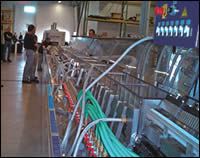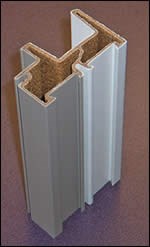First Direct Extrusion of Complex WPC Window Profiles
Wood-plastic composite (WPC) profiles are made by two main approaches.
Wood-plastic composite (WPC) profiles are made by two main approaches. Direct extrusion from raw ingredients dominates in deck boards and other uncalibrated profiles. However thin-wall, multi-hollow profiles, whose shape is formed with vacuum calibrators, are typically extruded from predried, precompounded pellets, which provide more consistent feeding and reduce the opportunity for formulation errors and surging in the die. For example, until now, all multi-hollow WPC window profiles have been made from pellets.
That could change as a result of new technology demonstrated last September by Automated Extrusion Tooling and Design, Ramsey, Minn., a 12-year-old firm specializing in dies and downstream tooling for WPC. It demonstrated production of a 50% wood-flour and PVC window lineal with two hollow compartments and two PVC cap layers (white and dark gray). Wall thickness of the 3.5-in.-wide profile was about 0.080 in., including the 0.010- to 0.015-in. cap layers that were introduced just before the die exit.
“This was the first time in the U.S. that a WPC window profile was directly extruded without predrying the fiber and pelletizing,” says Horst Eigruber, president of Extrusion Specialty Products, which built the system’s premixing and preheating sections.
Direct extrusion offers several cost advantages. “There’s an operating saving of 6¢ to 7¢/lb from not predrying and another 12¢ to 15¢/lb for not pelletizing,” Eigruber notes. The heart of the system was a parallel counter-rotating extruder (Krauss-Maffei model KMD 90-36). Compared with the conical twin-screws normally used for extruding WPC profiles, the parallel type is 15% to 20% less expensive than a conical for the same output, says Andreas Tuerk, sales manager for Krauss-Maffei.
There is also a difference in maintenance costs, he points out. Screw wear is comparable for the two types of machines, he says, but “when a conical barrel wears, you can’t reline it the way you can with a parallel twin-screw.”
Custom material handling
The big problem with direct extrusion of thin-wall profiles is the varying bulk density of the WPC raw material, which causes uneven feeding of the extruder and surging at the die. “Even slight variation causes a thin-walled profile to break as it’s pulled through the vacuum calibrators,” notes Donald Zoubek, president of Automated Extrusion. Melt pumps aren’t a solution because they create too much shear, overheat the WPC, and break the fibers.
The Automated Extrusion demonstration used special upstream mixing and preheating equipment to provide very uniform feeding of the extruder. The system was designed to feed undried wood flour, powdered PVC, and up to 20% WPC regrind. It used loaders from Hapman Conveyors on gain-in-weight gravimetric hoppers from Inoex LLC. The hoppers feed into a small paddle-mixing chamber, which feeds into a short (8:1 L/D) co-rotating twin-screw preheating extruder. Both were custom-built by Extrusion Specialty Products. The co-rotating twin-screw preheats the material to 180 F using electrical heater bands on the barrel and hot oil inside the self-wiping screws.
The preheated mix drops by gravity into the main extruder, flashing off most of the moisture, which is exhausted outside of the building. The extra-long barrel of the Krauss-Maffei extruder (36:1 L/D instead of the usual 26:1) allows for dual venting via an ambient-pressure vent in the first heating section and a high-vacuum vent downstream to pull off the last moisture and volatiles. The longer barrel also allows wider flights on the screws, which hold a greater volume of material for higher output than a standard 26:1 extruder.
The single-lane die from Automated Extrusion was a streamlined, round tri-extrusion tool. Downstream tooling consisted of four dry calibrators (which provide a better surface finish than a wet calibrator), followed by a water-cooling section and a series of template tanks with vacuum calibrators and water. At the demonstration, the line produced profiles at 10.5 ft/min. and about 400 lb/hr.
The die and vacuum calibrators for the demonstration were subsequently delivered to Andersen Corp., Bayport, Minn., for its Renewal line of replacement windows. Anderson does not practice direct extrusion—its windows are made with pelletized Fibrex WPC material, developed by Andersen’s Aspen Research unit.
Anderson’s patented technology keeps others out of PVC-based WPC window profiles. However, Aspen has begun to license its technology for applications other than windows. Trex Co., Winchester, Va., and LP Building Products, Nashville, Tenn., are early licensees, both making hollow, thin-wall deck railings with vacuum calibration and capstock. “We see great potential for Andersen and its licensees to streamline processes using the direct-extrusion approach,” notes Andrew Marine, general manager of Aspen Research
Related Content
Roll Cooling: Understand the Three Heat-Transfer Processes
Designing cooling rolls is complex, tedious and requires a lot of inputs. Getting it wrong may have a dramatic impact on productivity.
Read MoreHow Polymer Melts in Single-Screw Extruders
Understanding how polymer melts in a single-screw extruder could help you optimize your screw design to eliminate defect-causing solid polymer fragments.
Read MoreUnderstanding Melting in Single-Screw Extruders
You can better visualize the melting process by “flipping” the observation point so the barrel appears to be turning clockwise around a stationary screw.
Read MoreReduce Downtime and Scrap in the Blown Film Industry
The blown film sector now benefits from a tailored solution developed by Chem-Trend to preserve integrity of the bubble.
Read MoreRead Next
Making the Circular Economy a Reality
Driven by brand owner demands and new worldwide legislation, the entire supply chain is working toward the shift to circularity, with some evidence the circular economy has already begun.
Read MoreLead the Conversation, Change the Conversation
Coverage of single-use plastics can be both misleading and demoralizing. Here are 10 tips for changing the perception of the plastics industry at your company and in your community.
Read More














